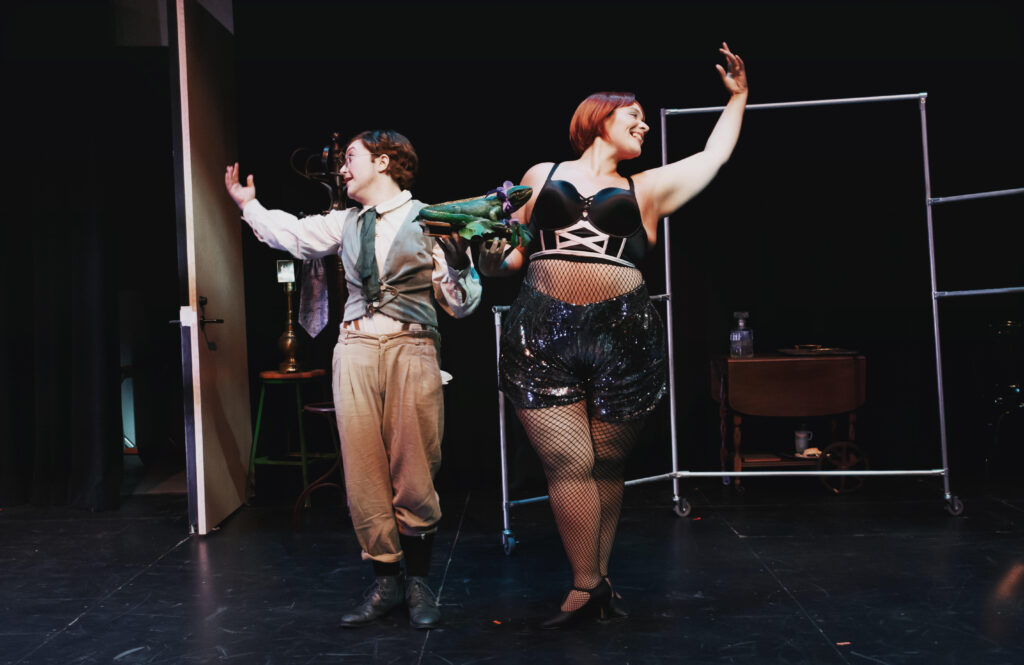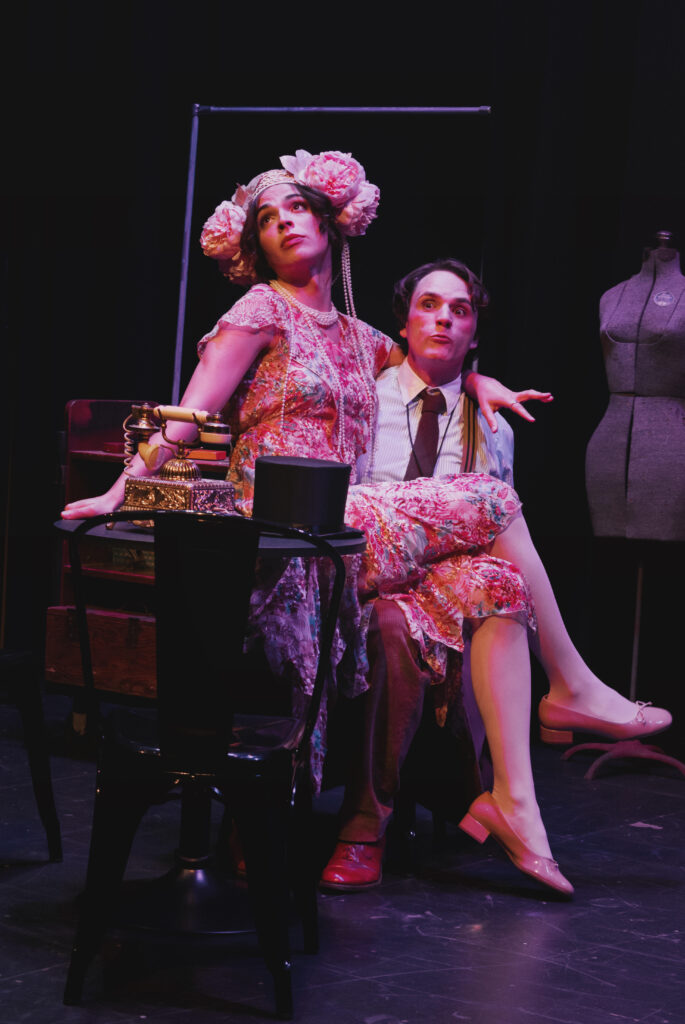
Lydian Meloccaro (HE/THEY) & Adriana Alvarez (SHE/HER). Photo by Tobias Bond-Richardson.
Presented by Pansy Rampant Productions
Play by Lawrence Gullo
Co-facilitation by Liz Diamond and Jo Michael Rezes
Costume design by Sherman
Scenic design by Ellie Gillis
Lighting design by M Berry
Hair/makeup design by Em Salzman
Featuring: Mandy Jo Bemis, Sebastian Crane, Leanna Hieber, Lydian Meloccaro, Justin Peavey, Matti Steriti
August 23-25, 2024
The Foundry
101 Rogers Street
Cambridge, MA 02142
Information here
Review by Maegan Bergeron-Clearwood
SOMERVILLE, Mass. — The not-so-roaring-2020s are a struggle-full time, particularly for queer folks who just want to exist in peace. Playwright Lawrence Gullo’s labor of love, Let’s Misbehave, transports us back in time almost a full century, not as a form of escapism, nor to prove that one era was crueler or kinder than the other, but to simply remind us that trans people have always existed – not only existed, but thrived. There’s profound hope in that simple sentiment, especially right now.
Gullo’s play has been simmering for over a decade, evolving from a TV pilot to a Zoom reading to this summer’s Boston stage premiere, and in that time, its characters have clearly had time to grow into their own. Fittingly, the play has something of a sitcom feel, featuring a merry band of friends who more or less just like hanging out together – except that these friends are queer social outcasts living in London in the 1930s.
Elle is our (literal) viewpoint character (played by Mandy Jo Bemis), a photographer who joins the group seemingly out of artistic curiosity, but soon becomes a member of the family. Their new companions comprise of: Jasper (Sebastian Crane), a Byronic aristocrat whose inheritance is on the line ; Morris (Lydian Meloccaro), an impassioned anarchist struggling to finish his manifesto; Bo (Matti Steriti), a flapper who wears her own designs; a Vicar (Justin Peavey, understudied by Geoff Moonen during my viewing) who moonlights as a trombonist; and The Countess (Leanna Hieber), the eccentric host who foots the bill and keeps her family safely under her wings.
Like the viewpoint characters in Cabaret and The Great Gatsby (it was hard not to be reminded of these artistic ancestors, both with their own queer histories, during the performance), Elle is seeking truth, something genuine beneath the façade of early 20th century class norms. The irony, of course, is that Elle’s companions are the most themselves under the seeming cloak of night, when they have the freedom to dance with their authentic partners, dress as their authentic genders, and laugh as their authentic selves. They may not have precise language to describe themselves, but Elle’s photographs don’t lie: they very much exist.
Let’s Misbehave doesn’t end like your typical queer period piece. Fear of transphobic violence looms over these characters’ lives, to be sure, but it doesn’t damper their love of life. The story ends with a decidedly joyful pause, rather than a grim resolution: one smiling snapshot out of what we assume are many to come.
Joy is this play’s most subversively successful quality, as well as its most dramaturgically challenging. The play gestures toward a traditional two-act structure but meanders into quippy character interactions, particularly in the second act. These scenes are delightful individually, but strung together, the pacing feels languid. And while I’m profoundly grateful that this is a queer story that doesn’t involve trauma, it also lacks conflict, resulting in a world that feels oddly low stakes.
Extensive research went into this production’s world-building, as evidenced by the program materials and Kickstarter page. Still, I found myself itching for more specificity of time and place. Decadent costumes (designed by Sherman) ground the visual world in the 1930s, and sparse scenic elements (Ellie Gillis) give the actors what they need to pull the story along, but lighting and sound design tweaks could have helped the production distinguish more clearly between the characters’ harsh daytime reality and lush nighttime paradise.

Matti Steriti (SHE/THEY) & Mandy Jo Bemis (THEY/SHE). Photo by Tobias Bond-Richardson.
There is also room for more time-period-specific texture in the writing itself, and I wonder if my feelings of alienation were due in part to the setting: England makes sense for a play that’s interested in the artificiality of class, but the play doesn’t otherwise feel particularly then-and-there, and given how much the actors struggled with accents, I’m not sure if the story justifies its non-American setting.
The play is still growing: there are hints at a genderqueer arc for Elle, for instance (inspired by collaborative work with the actor), that Gullo mentions teasing out in future iterations, and I wonder if clarifying the viewpoint character’s arc will give the story more direction.
Alternatively, conflict and stakes aren’t inherently necessary for good theatre. I can envision a tighter version of this play that fully embraces itself as a joyfully aimless romp, inviting audiences to simply party with the family in gay abandon.
There is infinite potential with this work: I would love to dance and drink champagne with these characters – particularly if they are given life again by these particular actors, who clearly connected with their trancestors on a profound, perhaps even spiritual level – and I hope that future iterations will either clarify its narrative arc or lean into immersive absurdity. Either way, I want this strange little world, with all its strange little inhabitants, to keep on living.
